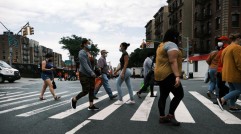Supreme Court to Hear 'One-Person, One-Vote' State Legislature Redistricting Lawsuit
The U.S. Supreme Court will hear arguments that may affect Latino voter engagement from Texas. The Supreme Court agreed to hear the case on whether states should not count individuals eligible to vote or the general population when drawing electoral districts.
The case stemmed from Texas voters Edward Pfenninger and Sue Evenwel. According to the Project on Fair Representation, a conservative legal defense organization, the two voters alleged the state's Legislature "malapportioned" the senatorial voting districts, which then-Gov. Rick Perry signed into law on June 26, 2013. Evenwel and Pfenninger's lawsuit asserted the Texas Legislature did not consider the number of electors and potential electors in the proposed districts when developing Plan S127.
"The lawsuit alleges that Plan S172 is unconstitutional under the Fourteenth Amendment to the United States Constitution and are seeking a court order requiring the Texas Legislature to reapportion state senatorial voting districts in conformity with the Fourteenth Amendment to ensure that all votes in Texas State Senate elections will be weighted equally with those of other qualified electors," stated Project on Fair Representation.
Project on Fair Representation noted, "In each of the 31 senate districts in Texas there are about 811,000 people, but there are wild disparities in the number of people per district who actually have the legal right to cast a ballot. Specifically, in Sue Evenwel's mostly rural district, about 584,000 citizens are eligible to vote. In a neighboring urban district, only 372,000 citizens are eligible. As a result, voters in the urban district have more sway than in the rural district; their individual electoral preferences carry more weight."
"The court has never resolved whether voting districts should have the same number of people, or the same number of eligible voters," New York Times' Adam Liptak reported. "Counting all people amplifies the voting power of places with large numbers of residents who cannot vote legally, including immigrants who are here legally but are not citizens, illegal immigrants, children and prisoners. Those places tend to be urban and to vote Democratic."
A win for Evenwel and Pfenninger could shift power from urban to rural areas. Urban areas are more likely home to immigrants and Democratic-leaning voters. Rural areas are more likely home to older populations and Republican-leaning voters.
After the Supreme Court announced it would hear the case, Evenwel and Pfenninger said, in a joint statement, "We are grateful that the justices on the Supreme Court have agreed to hear our case. It is to be hoped that the outcome of our lawsuit will compel Texas to equalize the number of eligible voters in each district."
Edward Blum, president of POFR said, "This case presents the Court with the opportunity to restore the important principle of one-person, one-vote to the citizens of Texas and elsewhere."
The Texas Latino population is 38.4 percent of the overall population, which is higher than the national average of 17.1 percent. According to the Migration Policy Institute, approximately 4.4 million people in Texas are immigrants, and more than three million immigrants are Latino.
The Supreme Court is expected to start hearings this upcoming fall and a decision in 2016.
__
For the latest updates, follow Latin Post's Michael Oleaga on Twitter: @EditorMikeO or contact via email: m.oleaga@latinpost.com.
Subscribe to Latin Post!
Sign up for our free newsletter for the Latest coverage!














